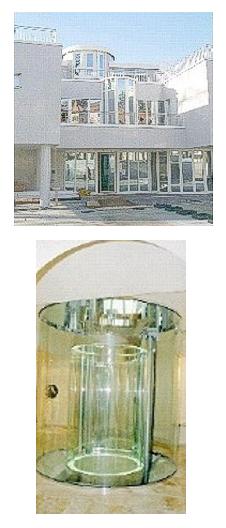The client, a top-level manager who works all over the world and has various houses throughout Europe, bought a villa in Davos in 1992, which he renovated according to his own requirements. The villa makes extensive use of ABB's EIB BMS components and systems:

Overview of the integrated functions:
1) Lighting control:
Lighting control involves the switching and dimming of lamps. As there are many groups of luminaires in the individual rooms, an impossible number of individual switches would have been required. The push buttons in the rooms, therefore, generally trigger scenes. The switching and dimming of the individual groups was carried out via touch screens, some of which are equipped with radio control, and then transferred via a gateway to the EIB. The central commands that are transmitted by the room control elements and the visualisation increase the ease of operation.
2) Control of shutters and sun-blinds:
Groups of shutters are integrated in scenes in a similar manner as the lighting. Central commands are then used to raise and lower the shutters and to carry out louvre adjustment. They are operated via push buttons and touch screens. A weather station protects the awning from rain and wind and supports the control of the atmosphere in the room with automatic sun protection.
3) HVAC:
A separate building control system was implemented for the entire heating, ventilation and air conditioning (HVAC) system. As the entire building is forced-ventilated using conditioned air, the regulation of these systems was implemented in the management system. The EIB serves as a field bus. The setpoint is recorded, and actual temperature with the room thermostat, and the values are transferred to the management system via analogue actuators. The calculated control variables for the individual room control (heating, ventilation and air conditioning) are returned to the EIB by the management system.
4) Display and report:
Various data can be displayed, such as the selected room temperature setpoint, the setpoint for room ventilation and the external temperature, as well as information about any open doors and windows or MCBs and RCCBs that have been triggered.
Some of this data is displayed locally on touch panels and some on the visualisation screen.
5) Door intercom system with camera operation:
Using the door intercom system, the entry gate, front door and the doors within the house can be opened from various locations. A camera control system, with five surveillance cameras, makes it possible to see the visitor on the external intercom. Since other operator stations were implemented for the gates and cameras using EIB, the EIB system assumes control of these stations via a gateway.
6) Intruder alarm system:
The intruder protection system was divided into an exterior and interior monitoring zone. Via a gateway, EIB accepts the necessary data for informing the user about the security status of the building on the visualisation screen. The status signals about the windows and doors are, of course, also used to influence the control of HVAC in individual rooms.
7) Fire alarm system:
In the same way, information about the status of the building is transmitted to the EIB by the fire alarm system. EIB accepts the signals via a gateway and routes the alarms to the user on the visualisation screen.
The picture shows the lakeside villa, and its innovative lift.
For more information, go to www.abb.com.